
is your online community to ask questions and share information about specific medical equipment you work with every day. medwrench.com THE MEDICAL PRODUCT SUPPORT NETWORK FALL 2023 DIGITAL MAGAZINE
MedWrench






1612 Virginia Beach Blvd, STE 202 Virginia Beach, VA 23454 SERVICE, SALES & REPAIRS SPECIALIZING IN EQUIPMENT INSPECTIONS, AUTOCLAVES, IMAGING, X-RAY, AND BIOMEDICAL REFRIGERATION. EQUIPMENT INSTALLATION EQUIPMENT SERVICES OEM-LEVEL INSPECTIONS IMAGING, ANESTHESIA & RADIATION BIOMEDICAL REFRIGERATION
MEET OUR TEAM
PRESIDENT John M. Krieg
ART DEPARTMENT Karlee Gower Taylor Hayes Kameryn Johnson
DIGITAL MARKETING Kennedy Krieg Cindy Galindo
ACCOUNTING Diane Costea
ADMINISTRATIVE Joanna Manjarrez ASSISTANT

DATA ENTRY Emma Vitkovitsky
THE FACE OF Ben Calibrating MEDWRENCH MEDWRENCH is a product focused support network where medical professionals, purchasing administrators, manufacturers, dealers and industry experts can provide opinions, share ideas, and gather relevant information on medical technology and equipment.

Table of Contents 4 COVER STORY Education, Leadership, & Career Growth 10 SERVICE DIRECTORY Everything You Need in One Place 14 INSIDER KNOWLEDGE Career Growth 20 BULLETIN BOARD Blogs, Expos & Events, Continuing Education & More 24 ASK THE EXPERT Innovatus Imaging 25 SHOP TALK Q&A from MedWrench Forums 31 TESTIMONIALS Why Use MedWrench?
12 COMPANY SHOWCASE Innovatus Imaging MEDWRENCH.COM | DIGITAL MAGAZINE 3
EDUCATION, LEADERSHIP, & CAREER GROWTH
4 DIGITAL MAGAZINE | MEDWRENCH.COM
BY COLLEEN HAUGEN-ORTIZ, YOHANS ABRAHA AND CHRISTIAN ALFARO
In the world of clinical engineering, biomed, or biomedical engineering – whatever the hospital may call you – t here is more to the job than just testing a unit or turning a wrench. There are many pathways that start in the shop that can grow into leading, creating or enforcing. It starts with figuring out what you love.
In my personal experience, I found that patient safety was very important to me. I watched as some hospitals put their interest before their patients which drove me to decide quality and regulatory was my route. For you, it could be a love of making goals and accomplishing them with your team. Leadership might be a fit for you. Perhaps your love is for the device itself and becoming a biomedical engineer might be your route
Once you figure out your passion, get to know people in that field. I went to an AAMI conference in Cleveland back in 2019 and met the person in my company that ran the quality program. I took the time to learn what I would need to know to work in quality. I looked at college programs that fit into that mix. I got acquainted with things I felt I lacked such as leadership (for example I
took the AAMI leadership certification course). I didn’t know much about DNV hospitals (my hospital was Joint Commission) so I studied the DNV site to learn about their audit process.
I believe everything starts with education and there is no reason to stop learning. I come from an education background and still go to college online. Biomedical technology is an ever-changing world, with the amount of research and development that goes into medical devices, it is important to stay up-to-date with the latest information but not only information. Where do you see weaknesses that you need to work on? Perhaps you can improve as a public speaker, or maybe you want some leadership skills so you can better speak to the C-suite at your hospital. There are many options for self-development and many of them are free or very affordable. Not every class costs thousands of dollars. It can be as simple as going on YouTube and watching videos on getting your CCNA certification or electrical theory. There are sites that teach master classes such as Coursera and Udemy which charge $20-$60 dollars a class. There are official routes such as taking online
courses through state colleges, but those will cost more. Maybe your company offers reimbursement for college classes with certain colleges (it doesn’t hurt to find out what your options are). It is also as simple as going to your local library (most libraries have online books as well) and finding books on a subject you want to learn about. Hoopla is a library app where you can read digital books or listen to audiobooks. Harvard offers leadership courses that you can take along with free webinars without having to get accepted as a student to take them. Get involved with local groups! Biomed groups often have manufacturers come and offer some type of training at meetings. Biomed groups make a point to try and stay up to date with the latest information as well as encourage subject matter experts to teach a class here and there for the newer generations coming into the field. Gain educa -
MEDWRENCH.COM | DIGITAL MAGAZINE 5
tion through your network! Get to know people who might know more about something than you do and learn from them.
The point is that we live in a world where there are avenues to gain new information from handy apps like quizlet to study almost any subject you can think of to taking classes on edx.com. Education is the most important part of your career and staying up to date or gaining new knowledge is key for growth.



LEADERSHIP
What comes to mind when you think of leadership? I believe it is someone who leads with integrity and who is a soundboard for their team. Demonstrating empathy and compassion for the individuals they serve beside. It’s not about your title or who’s in charge, it’s about the synergy you create when cultivating with one another, sparking thought-provoking conversations for your team to think bigger and in our space. Our purpose is to deliver safe patient outcomes. As a leader there should be no job too big or too small for you to execute. Owning the big challenges will empower your team to do the same, don’t wait for the memo!
Leadership should be a fun journey where you’re learning from your wins and your losses – not to mention others around you. It doesn’t get easier; you just get wiser!
Recognizing your teams’ wins is an example of great leadership, take time to publicly acknowledge their efforts in improving patient care.
As you may have heard, it’s not what you know but who you know. I personally believe it’s both. You need to be able to walk the walk. Networking is only as powerful as the effort you put into it! Effective networking can look many ways, ultimately, it’s establishing relationships with your colleagues, leadership team and industry friends. Once a relationship has been established this bond creates trust, and trust will go beyond measures. Networking creates limitless opportunities; however, you must truly believe it prior to it manifesting! Take time to research where to start, build a board of mentors that you can trust and lean on them for guidance and support. I would start by taking a deep dive with the resources that are available to you; whether that’s within your current organization, or an external group or association. It’s OK to participate in more than one group or association, in truth, it’s encouraged! The more exposure, the more knowledge in your tool bag. Effective networking can truly change the trajectory of your career path, you must hold yourself accountable and take the first step.
As you progress in the HTM field you’ll notice operating procedures keep you on track. A simple tool,
such as a checklist, can make sure you and your team have a consistent method to measure results.
Uniformity and consistency will improve efficiencies, reduce risk and provide guidance on correct processes. This consistent rigor will also provide a clear vision to your customers on how you identify your expectations/scope of work. Not to mention how operating procedures will assist new hires with tasks they’re unfamiliar with. The first step is communication – Are you communicating in the most efficient way to execute your goals? Do you truly believe in your messaging? A lack of communication and ambiguity will lead your team to paint their own image of you and eventually create a negative perception of the program. Have an open mind, breed curiosity and accept new strategies to improve overall workflow. Change is inevitable, even checklists adjust over time.
CAREER GROWTH
How do we define our path? Take a moment to ask yourself, “What is your purpose? What truly drives you?” In every moment of the day, we make countless choices. We choose the time we set our alarm, our first meal of the day, what we entertain ourselves with on the commute to work, and how to show up for the team and patients.
Through the years of COVID, we
COLLEEN HAUGEN-ORTIZ Healthcare Technology Management Quality Specialist at GE HealthCare
YOHANS ABRAHA Program Coordinator at GE HealthCare
6 DIGITAL MAGAZINE | MEDWRENCH.COM
CHRISTIAN ALFARO Encompass Site Health Team Leader at GE HealthCare
made the choice to show up at the hospitals daily. At every moment there is an opportunity to complete our tasks or to take it a step further, to seek ways to build our knowledge and skill sets, and to go beyond our comfort zone.
In order to advance your career to the next step, develop a plan and present it to your leadership. Take on new challenges. Don’t wait for the memo. Field service leaders have more than a day’s work managing service, de-escalating customer complaints, and working to accomplish their leader’s and company’s goals and objectives. This leaves
little time for them to consider what all of their employees desire in career growth. Annual and semi-annual reviews are a good opportunity to discuss professional growth and development, yet we should not wait for those conversations. Be the one to step forward and speak to your manager about future opportunities for advancement and the steps to get you there. Make it a point to look for resources and moments to learn from colleagues and those higher ranking within your company or customer base. Build a “Board of Mentors” of professionals making an impact. Schedule regular meetings
with them, mimic their best attributes and their methods. Revisit your plan consistently and have a cadence with your manager to maintain your trajectory, hold yourself accountable.
As we continue forward, we have the opportunity to reciprocate and become a mentor for someone else. This is a win-win! Supporting others who are looking to grow within the industry, pays it forward and supports your own continued development. Your ability to teach others will reinforce the lessons you’ve learned and recenter your focus to continue along your path.
BIOMEDICAL TECHNOLOGY IS AN EVER-CHANGING WORLD ,
“
WITH
THE AMOUNT OF RESEARCH AND DEVELOPMENT THAT GOES INTO MEDICAL DEVICES, IT IS IMPORTANT TO STAY UP-TO-DATE WITH THE LATEST INFORMATION
BUT NOT ONLY INFORMATION ON MEDICAL EQUIPMENT BUT PERSONAL GROWTH .”
- COLLEEN HAUGEN-ORTIZ
MEDWRENCH.COM | DIGITAL MAGAZINE 7
The parts and accessories
1 Quality & compatibility
Get access to OEM service parts, accessories, and consumables that are tested for quality and compatibility with your GE HealthCare equipment.
2 Product availability
Three reasons to buy your service parts and accessories from GE HealthCare
It’s not just about getting the right parts and accessories. It’s about giving the right care to your patients. When there’s no time for downtime, consider these reasons to order your parts and accessories directly from GE HealthCare:

Order
Order easier and faster with over 85,000 parts and accessories coming from 50+ distributors worldwide with availability verified in real-time.
3 Service & support
Shop parts, accessories, and consumables and schedule repairs online 24/7, or speak to an agent for assistance.
you need—when you need them
GE HealthCare service parts and accessories today at parts.gehealthcare.com or call 1-800-437-1171.
© 2023 GE HealthCare. GE is a trademark of the General Electric Company, used under trademark license. JB01941US
SEE THE BMET PACK IN ACTION!

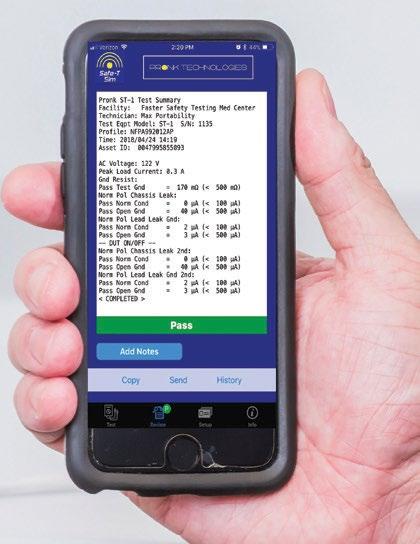
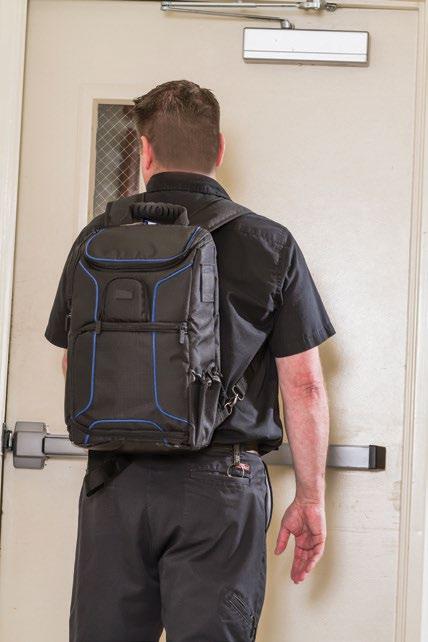



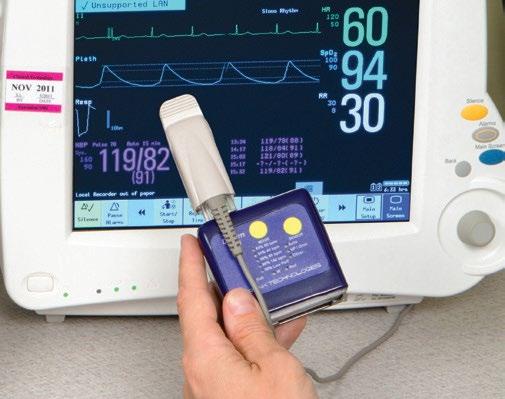
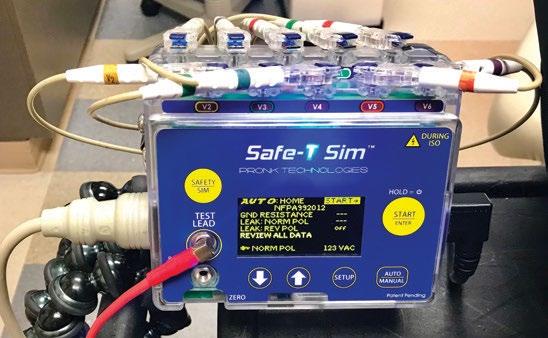




CONTRAST INJECTORS

SURGICAL

CARDIOLOGY ULTRASOUND IMAGING
SERVICE DIRECTORY AND SO MUCH MORE!
PATIENT
STERILIZERS/ AUTOCLAVES
MONITORING
INFUSION
Everything You Need In One Place 10 DIGITAL MAGAZINE | MEDWRENCH
BEDS, TABLES & CHAIRS
PUMPS
SERVICE DIRECTORY ADVERTISERS


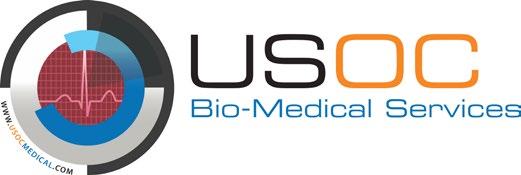








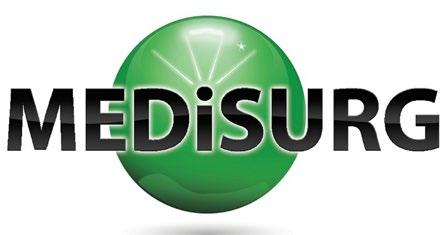
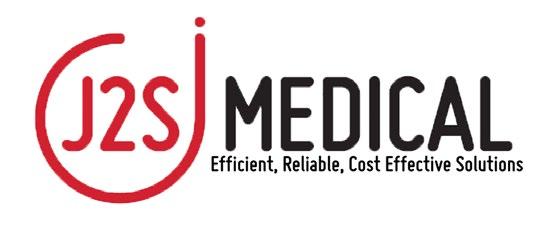


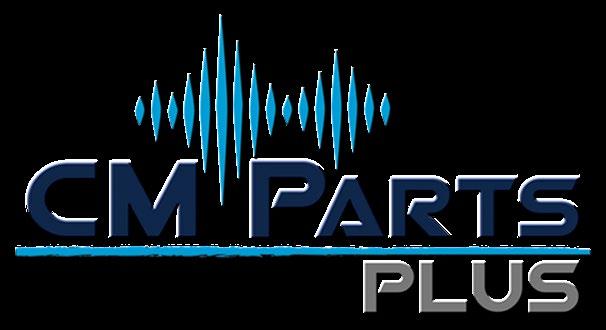

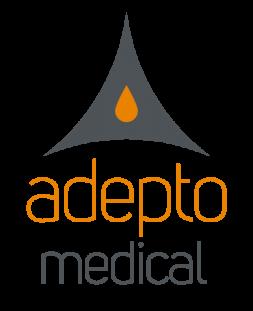
MEDWRENCH.COM | DIGITAL MAGAZINE 11
Company Showcase Innovatus Imaging
When seeking a physician, there are generally two categories – a generalist and a specialist. A generalist, such as a primary care provider (PCP), has very broad training, has a wide variety of experience and is able to treat most ailments. A specialist, such as a cardiologist, has had concentrated training and intensive experience that is focused on one specific ailment or anatomy part. “
As an Independent Service Organization (ISO), Innovatus Imaging is the latter”, says Matt Tomory, Vice President of Sales and Marketing. “We provide 2 depot-based services, ultrasound probe repair and MRI coil repair, and we do so with very high precision, ultra-consistency, with rapid turn-around times, and at a fraction of the cost of a replacement.
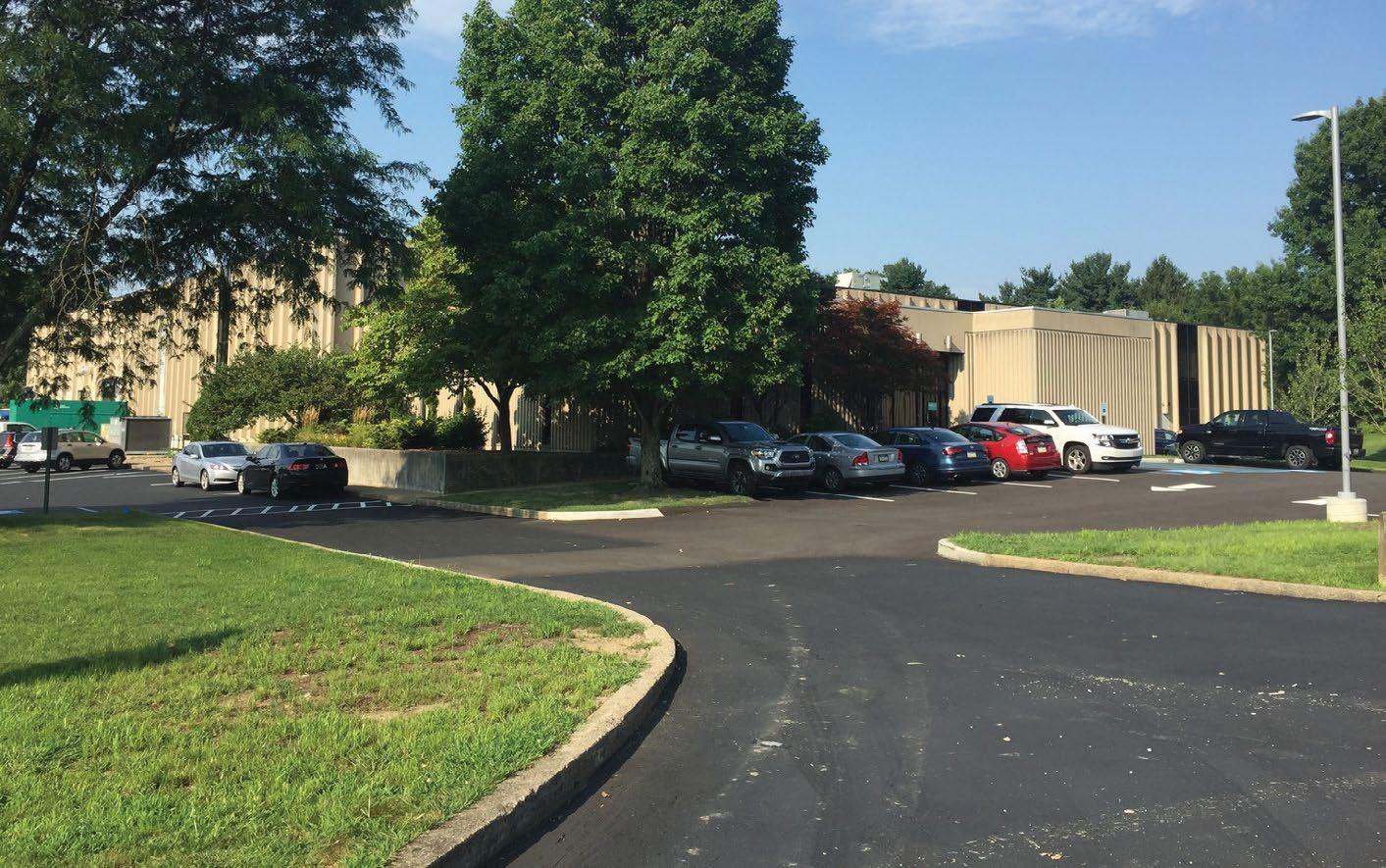
ORIGIN
The name was new in 2017, but the expertise, talent, processes, and exceptional outcomes that exist at Innovatus have been around since the mid-1980s. The company’s co-founder and Chairman, Dennis Wulf, is credited with being the founder of ultrasound probe repair in the United States.
Says Tomory, “We’re often asked, how did you get in the business of repairing ultrasound probes and MRI coils. It’s actually a very interesting story. Innovatus has a legacy in MRI coil manufacturing

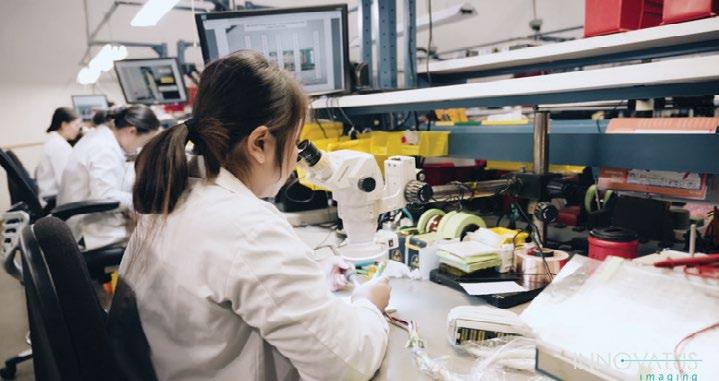
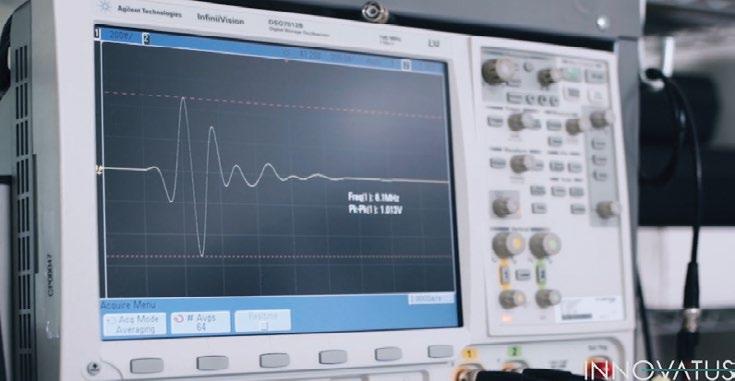
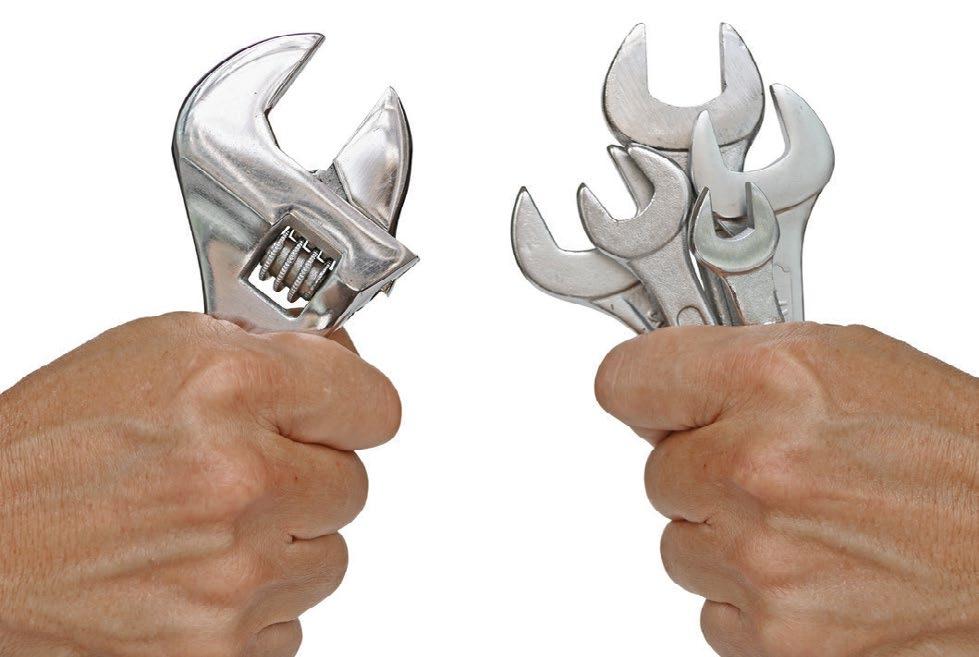
(with the Medrad brand of coils) and is also a current FDA-registered manufacturer of ultrasound probes, acoustic arrays, and ultrasound related devices for several prominent OEMs. We have the in-house engineering talent, proprietary fixturing and instruments, and expertise to fully understand the technology we repair. Innovatus is both an Original Equipment Manufacturer (OEM), and an Independent Service Organization (ISO). It’s quite unique in the HTM industry.”
 Ultrasound pulse testing
Probe wiring technicians
Ultrasound pulse testing
Probe wiring technicians
SPONSORED CONTENT 12 DIGITAL MAGAZINE | MEDWRENCH.COM
Cable stress testing
IMPROVED LONG-TERM VALUE
As an OEM, Innovatus applies a manufacturing mindset to their repair operations. The company’s cGMP’s (Current Good Manufacturing Practices), processes, procedures, and philosophies, used in manufacturing, are transferred to and inform those in the repair divisions. The holistic approach to repair provides longevity which helps ensure a lower total cost of ownership over the entire product lifecycle. The goal in Operations is not to just get a device working again, but to return a product, whether a probe or a coil, to the OEM form, fit and function and not alter safety, performance or intended use. In addition to enhancing efficiencies for health care facilities, Innovatus Imaging continuously explores new ideas and improves methodologies for repairing probes and coils to not only assure they perform as originally intended, but to also enable providers to extend the life of their equipment investments and lower overall operating cost.

INCREASED SECURITY AND PEACE OF MIND FOR HEALTHCARE FACILITIES
Integrated into each repair are foundations in research, material science, engineering, and technological innovation. Since 2000, the teams of engineers, subject matter experts, and repair technicians have restored the performance of more than 185,000 ultrasound probes and 40,000+ MRI coils. With such an extensive volume of repairs and specialized focus, Innovatus has accumulated tremendous amounts of failure analysis data which serves as a massive knowledge base for continual innovation, design, and development.
“Based on the particular product model, with a high degree of certainty, we know what to expect before the client’s product arrives at our facility. This is due to our proprietary, expansive and verifiable data which tells us not just what parts are likely to fail, but also how and when.”, says Jon Hoffman, General Manager of Innovatus’ Ultrasound Center of Excellence in Tulsa, OK.
OEM QUALITY AT ISO PRICING

As an independent service organization, Innovatus doesn’t have the massive overhead often associated with OEM sales, promotion, support, and distribution. Our Engineering and Operations teams engage in Continuous Quality Improvement activities and employ Lean
Manufacturing and Six Sigma principles to continually improve operational efficiencies. Savings and efficiencies are passed along to their clients in the forms of lower costs, faster service, longer warranty periods, and extended product lifecycle.
Our high success rate for repairs allows Innovatus to offer the industry’s longest warranty periods. “Based on our unique approach to repair and the methods of applying our 13485:2016 certified quality management system, we have the data to support a 12-month warranty period on all standard probes and 6-months on all other products. Our clients can have the same confidence in our products that we do” says Tomory.

WHAT’S IN IT FOR YOU?
Clients that choose Innovatus Imaging as a service partner have confidence in knowing that 1) The safety and performance of their devices has been entrusted to those with first-hand experience in manufacturing such devices, 2) The organization has a commitment to quality consistent with new device manufacturing and embraces practices to improve outcomes and lower costs, and 3) Is accountable to multiple OEMs, the largest asset management organizations, many ISO partners, and hundreds of healthcare organizations, but, ultimately, each patient on which their repaired devices are used.
For more information, please visit www.innovatusimaging.com

The word “INNOVATUS” is a Latin adjective that translates into “renewed”.
The name represents the company’s progressive approach to delivering cutting-edge medical devices and repair solutions which restore OEM intended design
Hydrophone testing
MRI system emulators
High-level failure statistics for 2-popular probe models
MEDWRENCH.COM | DIGITAL MAGAZINE 13
High-level failure statistics for the top-10 MRI coil models
This Insider Knowledge article for MedWrench includes the knowledge and opinions regarding career growth from of industry insiders, including RSTI’s Todd Boyland, Tri-Imaging Solutions’ John Drew, Innovatus Imaging’s Ted Lucidi, and Advanced Ultrasound Systems’ Rhiannon Thurmond.
INSIDER KNOWLEDGE
Q:Are certifications necessary or suggested for someone starting a career in HTM?
Boyland : This depends on the role, duties and responsibilities. Certifications may be required by the employer, or even the health care provider. Certification may be a way to separate candidates who are applying for various positions.
Drew : I will answer this leaning to the diagnostic imaging space specifically. Certifications lend to credibility or competency in a specific area or a general knowledge. If someone is entering into this space and has completed our BMET to Imaging courses, an employer can be confident they have a base of knowledge that can be built upon. Certain certifications for specific specialties may be required, but we have not seen much of that just to enter the field.
Lucidi : Until more employers require certification as a condition of employment, the importance of certification will be merely personal. In the industry’s current state, at best, possessing certification should provide a candidate with an advantage over someone who is not certified. Personally, I view certification as a commitment to oneself and to the HTM industry. To that end, I value certification, and would highly suggest seeking it. As a hiring manager, when considering between two individuals with similar experience, interpersonal skills, and personal recommendations, the certified individual would be my first choice.
Thurmond : Most minimum requirements to enter the industry are a standard 2-year A.A.S degree in biomedical equipment technology. I have seen and worked with HTM professionals that have alternative degrees pertaining to electrical engineering that have transferred their skill sets with additional mentorship. There are additional certifications like CABT, CBET, CRES and CISS that are suggested but not essential for all roles (usually employer dependent).
Q: How important is continuing education when it co mes to a successful HTM career?
Boyland : Very important. It’s obvious that technology evolves as equipment life cycles progress. It’s important that HTM education continues with the evolution of the technology to stay in front of the equipment, not behind.
Drew : I would say it’s critical for several reasons, but I will just give a couple. Personal growth. Engineers today are looking for continued growth with an employer, and educating and expanding skill sets is one piece of that plan. Due to the shortage of engineers, employers are requiring employees to cover more and varied systems. Continuing education is essential to make this successful for both the employee and employer. Once there is a base established, it can be the launching pad for other specific areas. Degrees are another way to distinguish yourself from another as well.
Lucidi : Extremely, never stop learning! Tech advancements are occurring at a much more rapid pace than they did just 5 to 10 years ago. Although the fundamental function of a device may not change, the manners in which technology is applied to a device does. Volunteer for every training opportunity and continually invest in yourself. Remaining status quo is the most effective means of obsoleting
Career Growth 14 DIGITAL MAGAZINE | MEDWRENCH.COM
oneself.
Thurmond : It’s the most valuable thing you can do for yourself in this industry. You should be staying up to date with technology as it advances, the lifespan for a medical device is roughly around 7 years in my opinion with so many of our medical devices relying on computers and with various OS revisions the likelihood of a device staying in the usable medical market is drastically reduced when integrated with a computer or proprietary software. You should also be continuing education in other facets of your life that may help you as well, working on soft skills that set you apart from the competition. It’s a competitive world out here so keeping your skills sharp is essential.
Q:I’ve heard some talk about apprenticeships for HTM. Can you share more about that?
Boyland : Apprenticeships can be helpful when training has been accomplished, but the trainee could benefit from real-world experience. Apprenticeships can help bridge the gap between the theory and practical experience that was learned during training, with real world experiences.
Drew : Sure, I can talk to our program here at Tri Imaging. We are having great success bringing new engineers into the field with our program. To date, we have had approximately 50 apprentices complete our program. It is a great way for a new HTM candidate to enter our industry with more than just a class under their belt. The program offers them a submersion into working with us day to day diagnosing, repairing, testing, and calibrating diagnostic imaging systems in
a controlled environment. The result of this is twofold. First, the engineer is far more comfortable when they enter the workspace. Having been exposed to multiple modalities such as X-ray, mobiles, C-arms, cath lab and CT. Second, the employer is confident that they are hiring someone who has been vetted and has more than just a basic understanding. We also work with our customer to tailor the training need of the apprentice to meet their needs.
Lucidi : Apprenticeships are very new to our industry, and I welcome them. They are a bridge that addresses the huge need for qualified individuals within HTM. I see apprenticeships serving several purposes. 1) Many recent high-school grads may not have developed a passion or drive that leads them to a particular field of study or profession. An HTM apprenticeship can help individuals learn more about the field, first-hand, and develop solid skills that prepare them for a potential future in HTM. 2) Another portion of the population may not qualify for financial aid and may not be able to afford the ever-increasing high cost of college or other higher educational opportunities. Successful completion of an HTM apprenticeship can enable the apprentice to work in the field and then pursue an option in higher education … a best of both worlds’ scenario.
Thurmond : There are several places where you can gain apprenticeships for HTM. Many hospitals and health care systems offer apprenticeship programs for individuals interested in HTM. You could also look at medical device manufacturers; many of which provide hands-on experience and training in efforts to hire the best prospects. Other places to look
would be tech schools and community colleges that offer apprenticeship/internship programs in HTM. These programs combine classroom instruction with on-the-job training to provide a comprehensive learning experience. Finally – use your social network to find out if your peers are already working with a quality firm that may know of any good internship programs!
Q:
What o ther fields of study should HTM pros consider?
Boyland : I would consider networkin g an almost mandatory base-level skill that will improve any HTM’s skill set. Cybersecurity is helpful and ever evolving, but the required depth of cybersecurity is more role based and may apply more to IT staff, although basic knowledge is certainly important.
Drew : As technology advances, there are a couple of other fields of study that become more and more important to HTM professionals. The first field of study that comes to mind is software. Understanding how to move around in Linux or some variant of it is another area. There is no need to be an expert, but an understanding of the basics is helpful. Networking and DICOM have been important for a number of years now and this will continue. There are more areas, but these few are a good start.
MEDWRENCH.COM | DIGITAL MAGAZINE 15
Lucidi : IoT is here to stay, and IoT’s use is only going to increase throughout health care. So many medical devices are connected to something more than themselves. Anyone entering HTM needs to have an understanding of networking. To increase one’s value to an organization, HTM professionals should consider educational opportunities in cybersecurity and advanced networking concepts. Although most of the corrective action in health care facilities will be addressed within IT departments, HTM teams can use their networking skills to successfully identify and troubleshoot communication/network issues.
Thurmond : Networking and IT will be used throughout your career, may it be setting up and configuring your hospital’s telemetry system, integrating printers, configuring your Zoll defibs, or troubleshooting send/ receive issues on an ultrasound/ MRI/CT; you will use it. Learn these skills early on and you will be able to troubleshoot much more efficiently, especially if pursuing imaging. It is also helpful to know the lingo when working with IT to solve problems. I would also consider business administration, as it will equip the HTM professional with management skills, finance, marketing and strategic planning.
Q:What are some tips for finding a mentor to help advance one’s career?
Boyland : Try to objectively identify your own areas of weakness, and areas that you could improve on. Identify people that have strengths in
those same areas and try to incorporate the skills they implement that make them successful. In summary: Surround yourself with people that are better than you in your areas of improvement.
Lucidi : I’ll defer this answer to the next question, as I believe that great opportunities exist in local HTM associations. I also encourage those new to HTM to seek out every opportunity to learn. Accompany a more-experienced service engineer on a service call to learn more about a new device type or more technically complex device. Ask to attend a planning committee meeting that might be discussing the installation of new devices.
Thurmond : Know who your resources are and build a solid network, once you have an established network find your idols and ask them questions. See if you can help with projects or even just observe them in action. I encourage you to get on LinkedIn and make connections with people with similar interests to you. Interact and engage with the folks you align with! Attend conferences pertaining to your industry and get to know your support systems. Stay in touch and build relationships wherever you go. I have met many great mentors at conventions like MD Expo and AAMI. Get involved in clubs that are affiliated with your profession, make friends and build your resource book!
Q: What are the benefits of joining a local or national association like CABMET or AAMI?
Boyland : Local and national associ -
ations both have benefits. Affiliation with larger associations like AAMI present educational and networking opportunities with members throughout the industry. Local conferences and shows might present fewer opportunities, but those resources are local to you, for which involvement can prove very fruitful.
Drew : There are some great benefits to joining local or national associations. It is pretty simple to explain and straight forward. Being part of these organizations will help an engineer understand who and what is available in their area. Networking is key in all industries, and ours is no exception. I have made lifelong contacts who have helped me along the way. Today’s new engineers are tomorrow’s leaders.
Lucidi : I personally consider local associations to be a great source for professional development. Typically, each month, local associations will host an educational session on a particular topic. They’re a great resource for expanding one’s knowledge base. Local associations are also excellent opportunities to network with others in the HTM community. Some associations meet in-person, others purely virtual, and yet others alter their meetings throughout the year. I believe that the best opportunities lie in in-person meetings; however, virtual meetings offer a great convenience to those not in close proximity to the local chapter.
Thurmond : Networking opportunities, professional development, access to resources, career advancement, community support, and perhaps even
16 DIGITAL MAGAZINE | MEDWRENCH.COM
a seat at the table to contribute information and shape future policies.
Q:What else do you want to share with members of the MedWrench community?
Boyland : A re cipe for long-term success looks like a pyramid with a foundation base layer including education and industry-leading training. The layer above training includes experience, followed by long-term career success on top.
Drew: We have been talking to people for years about the need for new engineers in our industry. The early warning signals are long gone. We are deep into a severe shortage of diagnostic imaging engineers. I would
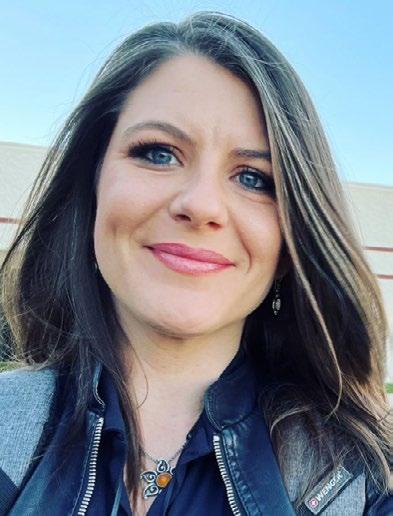
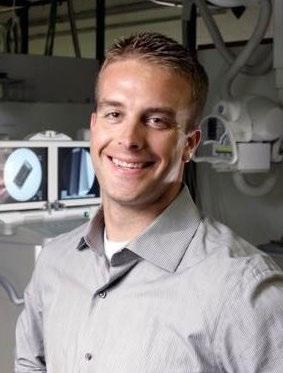

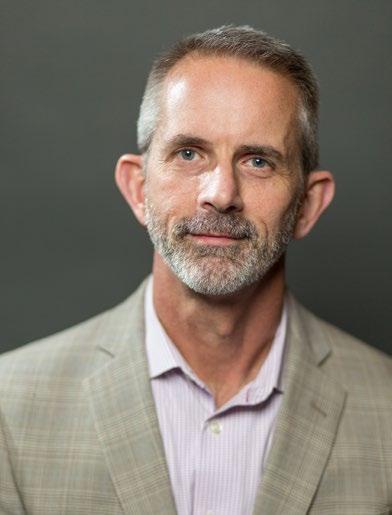
encourage anyone who is interested in a career field that has great pay, a good work environment, and longevity to visit our website, www.triimaging. com, and enquire about our programs to get started.
Lucidi: Another great resource for educational opportunities is through HTM tradeshows. OEM training seems to focus on content and tools that the design engineers want customers to use. Education provided by independent service organizations often focuses on actually servicing the device. Content typically includes tips and tools to address common failures found in the field and troubleshooting by NOT relying on diagnostics. Innovatus welcomes the opportunity to sponsor local HTM associations and facilitate training
sessions for their members. If readers would be interested, they can contact training@innovatusimaging.com.
Thurmond : The biomed field is constantly evolving Stay up to date on the latest advancements, industry standards, and best practices through continuous learning. Build a solid foundation and develop a solid understanding of the fundamentals on the front end so that you will be prepared on the back end. Seek mentorship, network, stay organized, be adaptable, embrace your team, and prioritize patient safety in your decisions. Lastly, take care of yourself – the biomed industry is demanding and stressful. Take care of your physical and mental well-being and seek support when needed.
MEDWRENCH.COM | DIGITAL MAGAZINE 17
JOHN DREW Tri-Imaging Solutions
TED LUCIDI Innovatus Imaging
TODD BOYLAND RSTI
RHIANNON THURMOND Advanced Ultrasound Systems




SOLUTIONS We have the key to your success. ISO 13485:2016 certified Become an Imaging Engineer. Start an exciting career as a Medical Imaging Service Engineer with the Apprentice Program at Tri-Imaging! We have world-class hands on training facility at our facility in Madison, TN. 2 WEEKS BMET to Imaging 1 training 2 WEEKS BMET to Imaging 2 training 8 WEEKS Technical Services 12 WEEK APPRENTICE PROGRAM Visit triimaging.com/training/training-program.html to see our 2023 Training Calendar! 855.401.4888 Located in Nashville, TN
BULLETIN BOARD

The Bulletin Board is an online resource where medical equipment professionals can find all the information needed to help them be more successful. This easy to navigate section gives you access to informative blogs, expos & events, continuing education and more. Visit MedWrench.com/BulletinBoard to learn more.
SOLUTIONS

Contrast Injector Service Training September
MRI Phase 2: Advanced MRI Service September 19-22, 2023
18-22, 2023
Visit MedWrench.com/Bulletin-Board/Continuing-Education for more
and to
Aquilion Prime Training September 25-29, 2023 BMET to Imaging 1 October 9-20, 2023
CONTINUING EDUCATION
details
register for these upcoming classes.
20 DIGITAL MAGAZINE | MEDWRENCH.COM
September 24-27, 2023
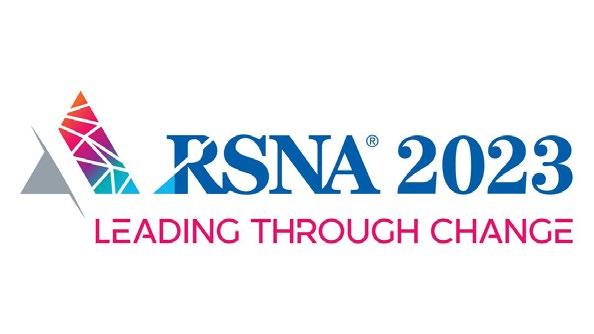
UPCOMING EVENTS
Get ready for these events coming soon!
October 27, 2023
BLOG: What’s Next?
October 26-27, 2023

I was asked some time ago if I would be interested in writing a blog post, but I have procrastinated, not sure of what I had to say. I decided to focus on the one thing that has haunted my mind since assuming my latest leadership role: What’s next?

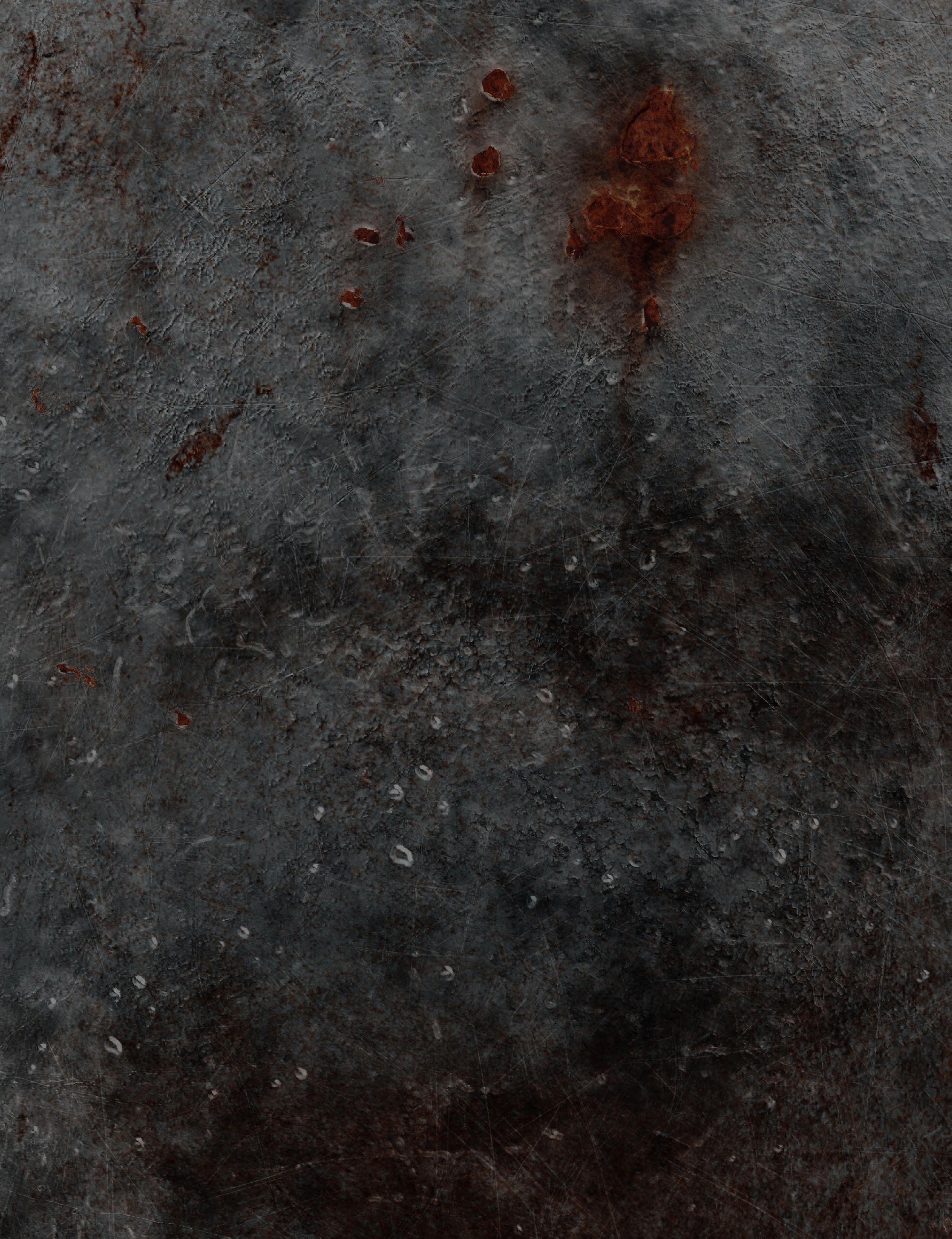
November 26-30, 2023
BLOG: Bridging Communication Gaps
As a biomedical engineering technologist in a healthcare setting, effective communication is essential to ensuring that medical equipment and devices are properly maintained. However, communication gaps can arise between biomedical engineering technologists and healthcare professionals, which can lead to errors and delays in patient care. Bridging these communication gaps is therefore critical to the success of the healthcare organization and the safety of patients.

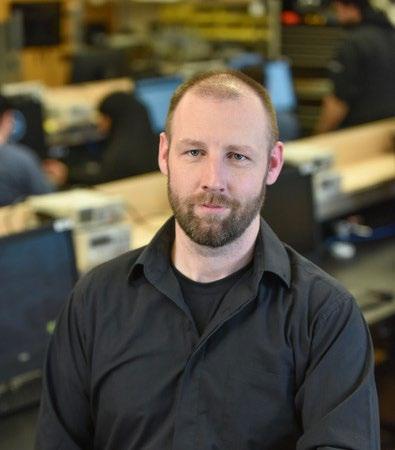

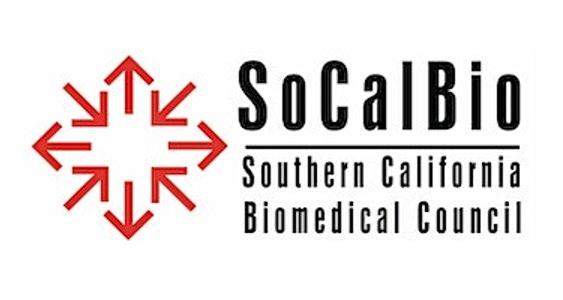 - Paul Neher, BS, CBET
- James Linton, Engineering/Operations Director
- Paul Neher, BS, CBET
- James Linton, Engineering/Operations Director
MEDWRENCH.COM | DIGITAL MAGAZINE 21
eLearning Classes
SEPTEMBER 11-15
PACS - Phase 1
SEPTEMBER 18-22
PACS - Phase 2
SEPTEMBER 13-15
Principles of Servicing
Ultrasound Systems
Phase 2 on September 25-October 6 is full. Anyone looking to book for Phase 2 should look ahead to October 30-November 10.
SCAN ME
On-Site Classes
SEPTEMBER 11-15
Siemens Ysio
SEPTEMBER 11-22
Principles of Servicing
Diagnostic X-Ray Systems - Phase 1 (limited seating available)
SEPTEMBER 18-20
Servicing the Philips Epiq 5 & 7
SEPTEMBER 25-
OCTOBER 6
Principles of Servicing
Multivendor CT Systems
OCTOBER 2-13
Principles of Servicing
Multivendor MRI Systems
(833) 229-7784 | rsti-training.com | rsti@rsti-training.com
SPECIALTY CLASSES: SPOTLIGHT ON
STATE OF OHIO REG. NO. 93-09-1377T
Looking to hire?
• 2,500+ qualified, actively looking biomedical and imaging candidates
• A variety of posting and recruiting packages
• Social media, print, eNews promotion
Looking to change careers?
• 300+ open HTM positions in nearly every state
• A variety of employers
• Free and confidential registration and application process
W E L C O M E T O T H E F U T U R E OF HTM CAREERS HTMJOBS.COM
ASK THE EXPERT
MIKE LABREE Innovatus Imaging
What does a Center of Excellence provide your ultrasound clinicians
For this Ask the Expert article, we interviewed Mike LaBree, chief technology officer, at Innovatus Imaging. Mike’s a well-respected authority in the ultrasound and acoustic design community. He’s worked for industry leading organizations such as Tetrad, W.L. Gore, and Soma Access Systems before co-founding MD MedTech which is now part of Innovatus Imaging. Currently, Mike oversees Innovatus Imaging’s Ultrasound Design and Manufacturing Center of Excellence which designs and manufactures specialty medical ultrasound products for OEM’s, transducer arrays for Innovatus’ Ultrasound Repair Center of Excellence, and research markets.
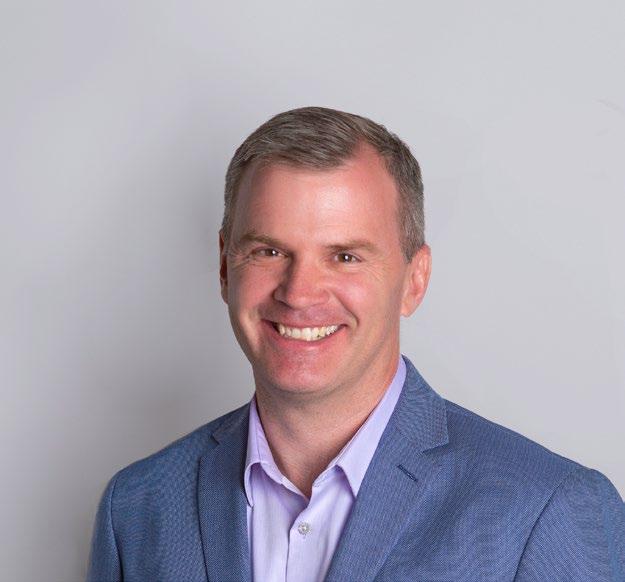
Q:There’s a lot of debate surrounding the Right to Repair movement. What is a key question that HTM professionals need to be asking?
A: I think that one of the questions that needs to be answered by anyone in the medical device service industry is, “Are the products that we are handing back to our health care providers clinically safe and effective?”. How that occurs will differ in each healthcare facility, but ultimately, clinicians need to be able to rely upon HTM teams and ISOs to ensure their medical devices are safe and effective and performing as the OEM intended.
Q:Every few months, it seems as though there are new companies promoting ultrasound probe repair. How does Innovatus Imaging differentiate itself from other sources in the market?
A: That’s a very good question. Many in the HTM industry are unaware that Innovatus is an FDA-registered manufacturer of ultrasound
probes and ultrasound related devices - that’s a very strong differentiator. The team at Innovatus has expertise in the design and manufacturing of ultrasound probes for OEMs and possesses all the related technology and know-how to benchmark and qualify ultrasound probes and arrays for release to the market. The other differentiator is that we specialize in ultrasound probe repair. We are not an organization that provides field service, replacement parts, tech support, and training on the scanner consoles…and also offers probe repair. We do one thing, and we do it very well. It’s one of the reasons that we’re trusted partners to several OEMs, multiple asset managers, IDNs and even other independent service organizations (ISOs).
Q:What types of test devices are used in your facility?
A: We have a multitude of devices and processes to qualify the safety and performance of ultrasound devices. Devices, such as a hydrophone and a radiation force balance, are used to quantify a probe’s acoustic output. These provide 3D mapping and measurement of the acoustic pressure field being emitted from a probe. A pulse-echo test, as seen in the header photo, enables us to visualize and measure the acoustic pulses from each individual element within an ultrasound array. This device twists and turns cables, wiring harnesses, and strain reliefs hundreds of thousands of times to benchmark and qualify performance and longevity. We also measure and document the face temperature of ultrasound probes to confirm that it remains in compliance with federal regulations and international standards.
Q:Thissounds very complicated. Are devices such as these needed by HTM teams in the field?
A: HTM teams test probes to determine whether the function of a probe has degraded in a way that would impact safety or efficacy. For this purpose, appropriate tools are a tissue mimicking phantom, properly functioning scanner, and an electrical safety tester. Organizations such as the American College of Radiology (ACR) and American Institute of Ultrasound in Medicine (AIUM) provide guidance to help end-users screen their probes for clinical use. Innovatus’ technical teams can also host webinars and train HTM professionals on how to utilize a phantom and how to assess probe performance in the field.
An OEM manufacturer (and/or repair organization) tests probes for many additional reasons. These can include ensuring that a repair process hasn’t impacted the product design, to monitor process variation across all products, and to detect and address subtle differences in products such that trends are detected before they impact functionality. This is analogous to an automobile transmission manufacturer who statistically controls all the dimensions of critical components in a transmission vs. the ‘health check’ that many mechanics perform when a car is brought in for service. The mechanic could invest in all the tools to measure every component in the transmission, but why would they – it doesn’t provide them any value, they may not fully understand what they are testing, and the results would only indirectly answer the question they are asking, which is whether the transmission continues to work acceptably or not.
SPONSORED CONTENT 24 DIGITAL MAGAZINE | MEDWRENCH.COM
SHOP TALK
SIEMENS BIOGRAPH MCT
Q:UPMM Cutting out during scans. Anyone experience this and have a solution? EKG will randomly cut out during scans. Replaced UPMM 3 times. Same issue. It will cut out mid scan won’t come back up either afterwards. Reboot doesn’t bring it up either. Have to do full UPMM reset procedure to get it back. Also tried new leads and trunk cables.
A:I am no MI expert, but I am an expert on the Definition series CT systems so here’s my best shot at your issue. I am familiar with the PMM as it’s called on the CT system and some of the “odd” problems it can cause. You mentioned that the UPMM has been replaced x3, I am assuming that means the PCB interface located at the foot end of the PHS. You also mentioned replacing the leads and “trunk cable” all with no change. Here are my questions to you:
1) Does this ONLY happen with ECG Gating?
2) What does the Siemens service Eventlog list as errors? Without answers to these questions, I will give you the best information I can as an “overview” of troubleshooting the UPMM option. Here’s the thing about an ECG interface to any system. It’s entirely related to timing and trigger control. From some of my support documentation, I can see that the UPMM interface connects to what I believe is the Connector Module located in the heel of the PHS support column. From there it runs through the cable chains within the Table Tray to the PET gantry. In the PET gantry, the UPMM interfaces to the Gantry Interface Module (GIM). Basically, everything to do with the operational functions of the PET goes through the GIM. The GIM then connects to the Universal Master Stationary Control Unit (UMAS) located in the CT gantry and the Acquisition Control System PC (ACS) for PET image acquisition. The UMAS passes the “Gating Data” received from the GIM through to the Patient Table (PHS) Master Control Unit (LMAS) as well as the Image Control System PC (ICS) for CT image acquisition and overall PHS position control. This is the “timing and trigger control” mentioned earlier. If all this is not happening in the correct order, in the correct amount of time, the scan will “lose its relative
PHS location/position or fail to trigger the Start/End of the scan sequence” thus causing a Scan Abort. Additionally, these appear to be the “Minimum” connections necessary and there can be several more depending on the age of the system, specific optional hardware configuration, and the optional software licensing and configuration. I strongly recommend verifying all cable connections throughout the UPMM cable chain and to any interface device those cables connect. There may be a mix of D-sub 9-pin serial, RJ-45 Ethernet, 2-pin VDC power, and fiber optics off the top of my head but there may well be others too. Special attention to FO and RJ-45 cables as these are the primary “signal” carrying cables between all the primary control units and PCs.
is compiled from our website! Go to MedWrench.com community forums to find out how you can join and be part of the discussion. SHOP TALK MEDWRENCH.COM | DIGITAL MAGAZINE 25
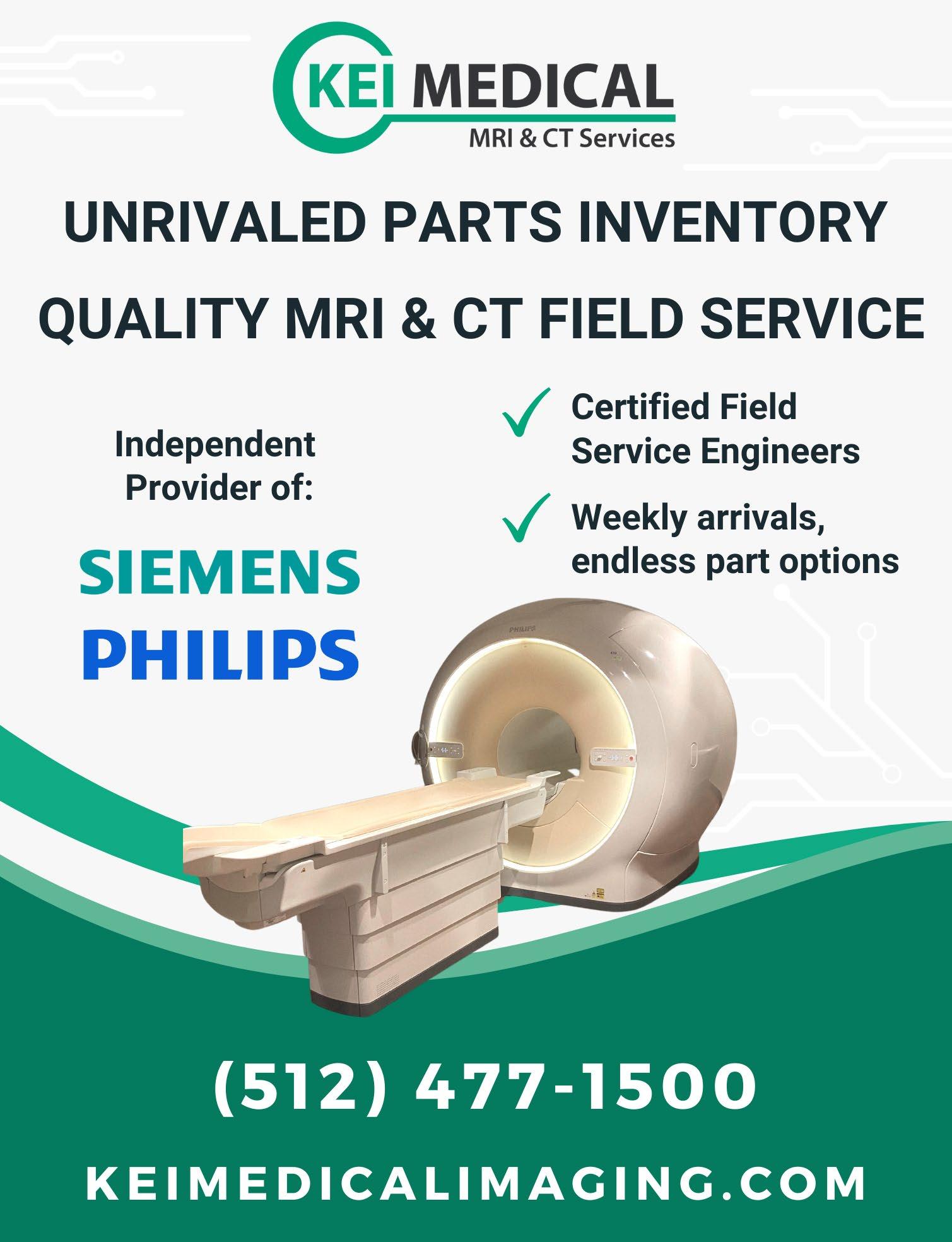
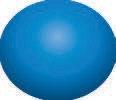
We have expanded our calibration service area to include Missouri, Illinois, Texas, Louisiana and Oklahoma. Our Fluke Biomedical Sales Territory is now includes Alabama and Mississippi. We provide authentic imaging and biomedical parts through our OEM allegiant relationships. sebiomedical.com | (888) 310-7322
NEW TO MEDWRENCH? MEET BEN C.
Since 2010, the face of MedWrench is Ben Calibrating or Ben C. for short. While he may just be a small Lego figure, you can find him all over the world.

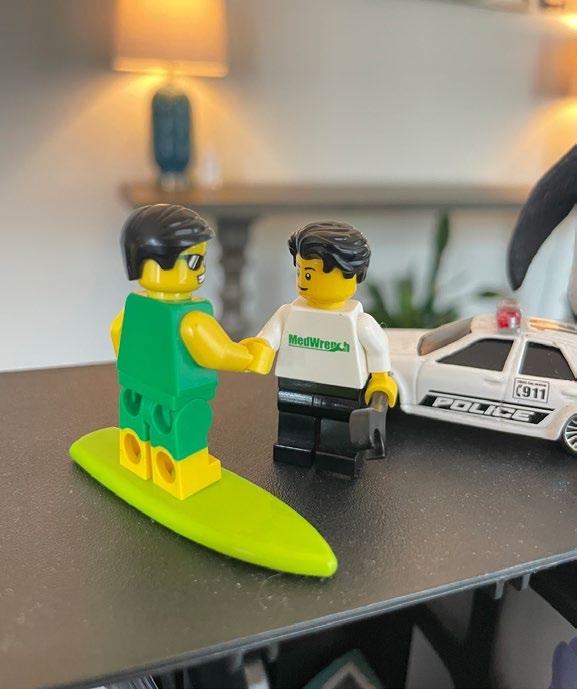





• Is he helping to fix broken equipment at your facility?
• Is he fighting off sharks at the beach?
• Is he crowd surfing at a concert?
The possibilities are endless! How does Ben C. do these amazing things? That’s where you come into play. MedWrench has an ongoing photo contest to see where Ben Calibrating is traveling to and what he has been up to.

WANT YOUR OWN BEN C?
Follow MedWrench on Facebook and LinkedIn and checkout the Expos and Events section of the Bulletin Board on MedWrench.com to find us at an upcoming show!

Post your pics on Facebook or LinkedIn using #BenC and tag @MedWrench.
Follow Ben C. on Instagram at @BenCMedWrench.
BEN C. PHOTO WINNERS:
28 DIGITAL MAGAZINE | MEDWRENCH.COM

Orlando, FL • October 29-31, 2023
AND FIND
IF YOU DARE MEDWRENCH.COM
COME
US

Join industry professionals to share ideas and gather relevant information. Our mission is to be the go to resource for the medical equipment industry. Don't miss out on this amazing opportunity to connect, learn, and grow with like-minded individuals. MEDWRENCH.COM GOT FORUMS? HERE Click to view our forum page
TESTIMONIALS
TELL US WHY YOU USE MEDWRENCH! CLICK HERE!
“MedWrench is a website packed full of information you need to complete projects, purchase products and ensure correct processing and use of equipment.”
“MedWrench is a great resource for finding out about the newest advances in medical equipment and various sources that deal with med equipment repair and issues.”
“MedWrench is an online community of hospital machines for the cool nerds.”
“I use the forums to search for error codes that may have happened to other biomeds.
-
“All in one website for those who want to continue learning about the different elements within the CE industry.”
“A great source for info and a good place to help others in need of expert advice.”

“A must have for any HTM professional.”
“A site focused on supporting the HTM professional, giving them instant access to industry experts to address topics and equipment relative to their day-to-day functions.”
- Julie Gottlieb, Account Manager Intl
-
Ted Lucidi, Customer Experience & Clinical Insights
Scott Williams, BMET Il
- Amanda Vanderhoof, BMET Il
- Jina Walls, MedWrench Guru
- Una Hamer, Sterile Processing Supervisor
- Ed Bican, Lead Tech
- Elkin Lara-Mejia, Biomedical Engineering Manager
MEDWRENCH.COM | DIGITAL MAGAZINE 31
THANK YOU! TO OUR 165,000+ USERS - Ben C.
is a product focused support network where medical professionals, purchasing administrators, manufacturers, dealers and industry experts can provide opinions, share ideas, and gather relevant information on medical technology and equipment. We want to say thank you for all of our users over the years. MedWrench wouldn’t be here if it wasn’t for our users!
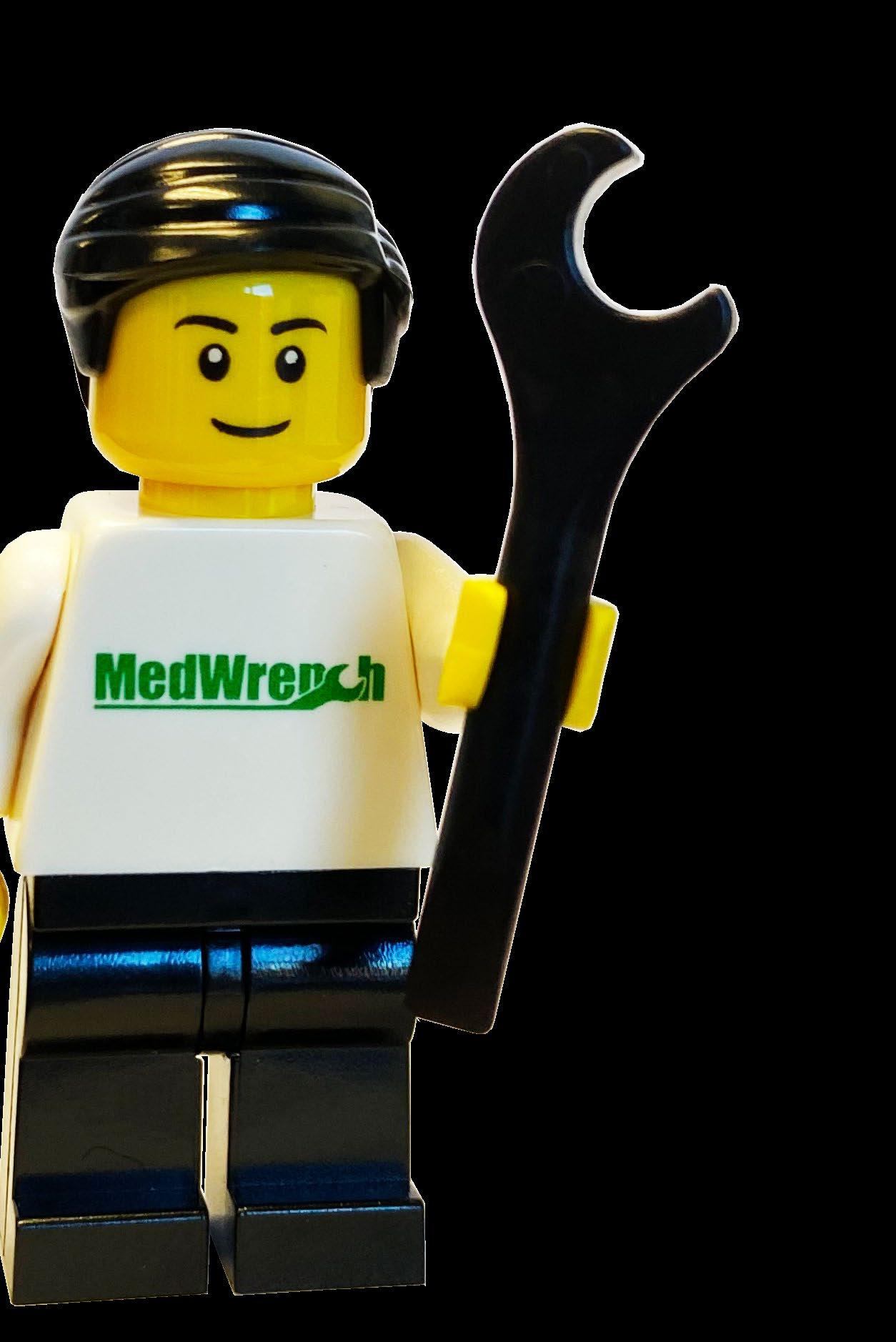
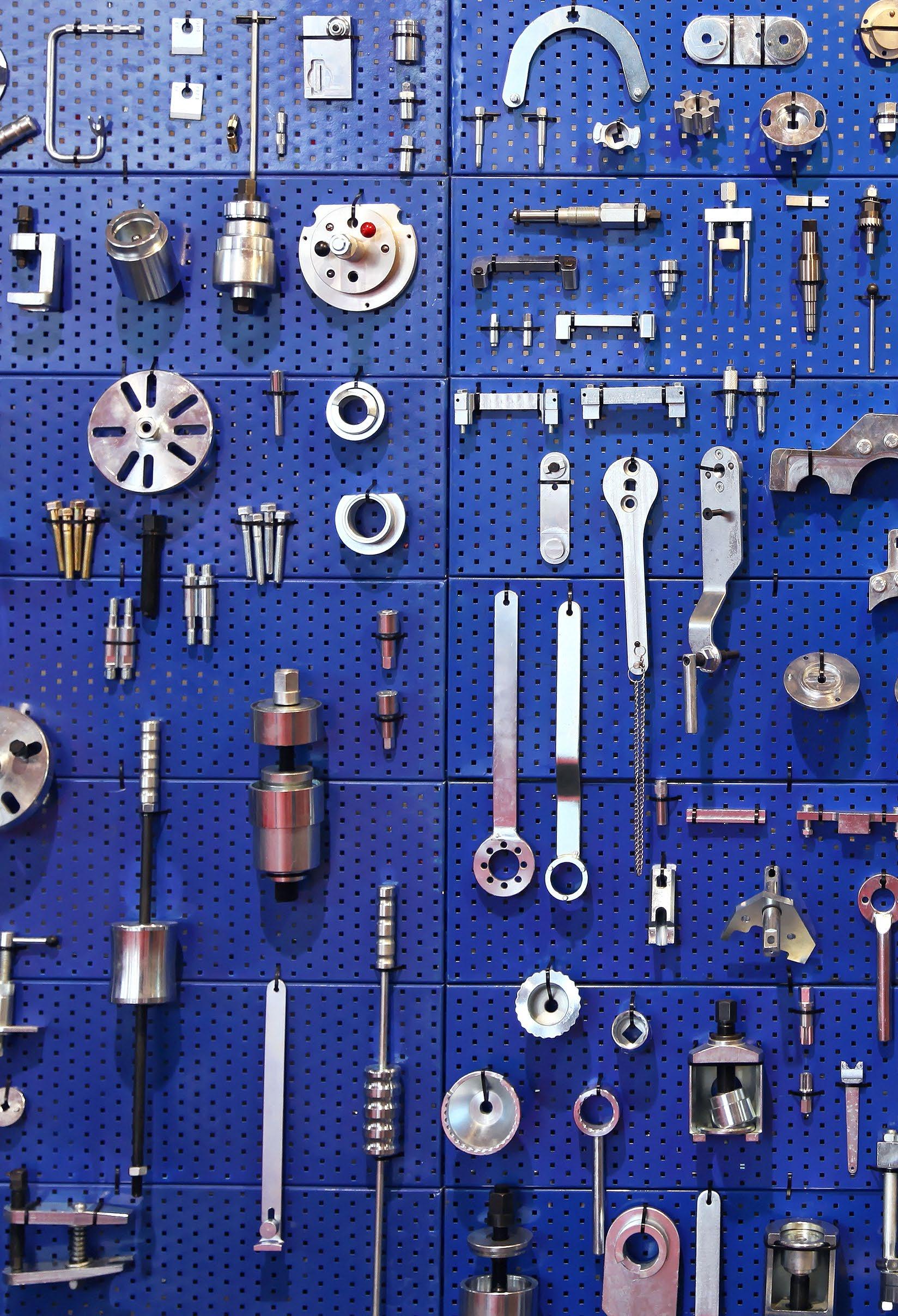
REGISTER NOW!



















































 Ultrasound pulse testing
Probe wiring technicians
Ultrasound pulse testing
Probe wiring technicians





















 - Paul Neher, BS, CBET
- James Linton, Engineering/Operations Director
- Paul Neher, BS, CBET
- James Linton, Engineering/Operations Director















